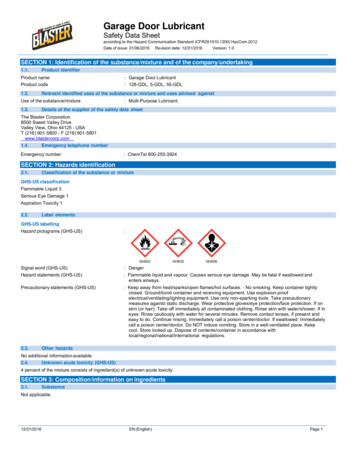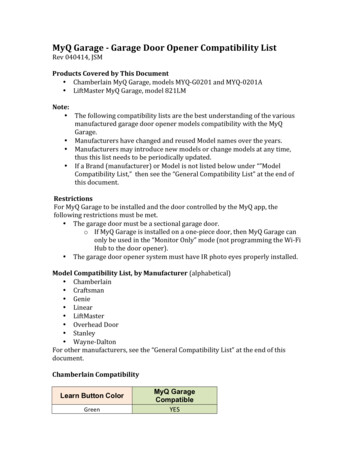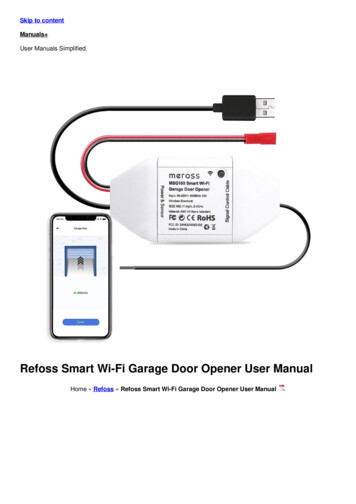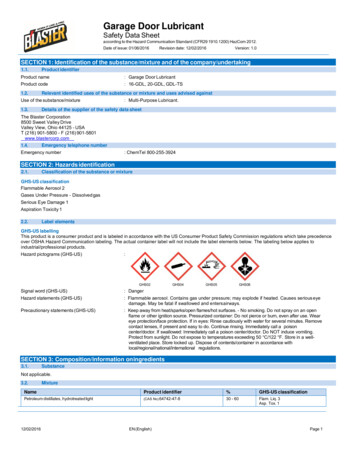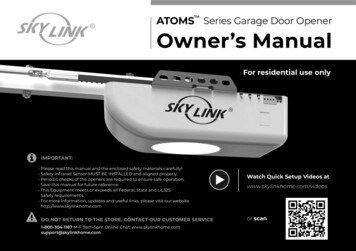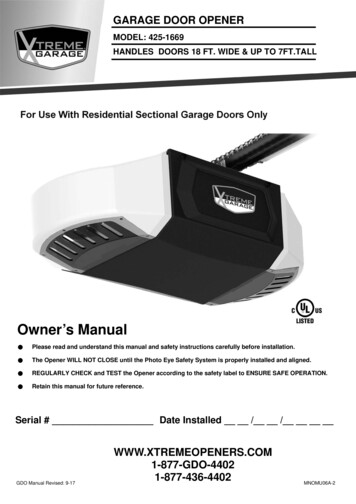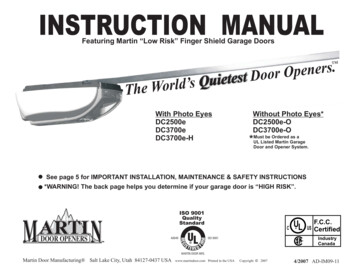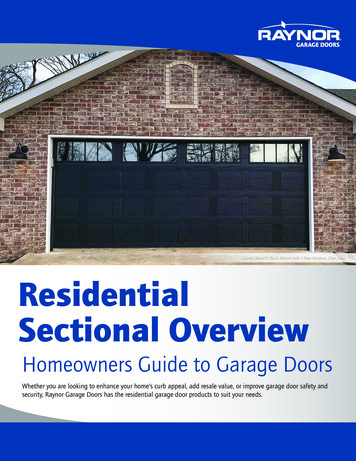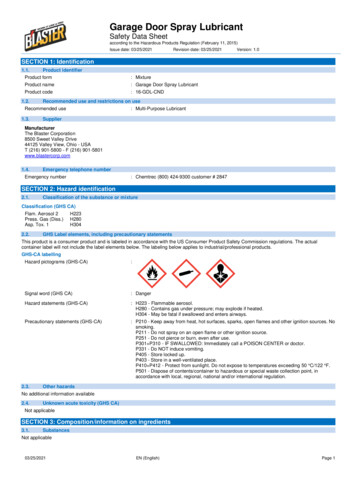
Transcription
Garage Door Spray LubricantSafety Data Sheetaccording to the Hazardous Products Regulation (February 11, 2015)Issue date: 03/25/2021Revision date: 03/25/2021Version: 1.0SECTION 1: Identification1.1.Product identifierProduct form: MixtureProduct name: Garage Door Spray LubricantProduct code: 16-GDL-CND1.2.Recommended use and restrictions on useRecommended use1.3.: Multi-Purpose LubricantSupplierManufacturerThe Blaster Corporation8500 Sweet Valley Drive44125 Valley View, Ohio - USAT (216) 901-5800 - F (216) 901-5801www.blastercorp.com1.4.Emergency telephone numberEmergency number: Chemtrec (800) 424-9300 customer # 2847SECTION 2: Hazard identification2.1.Classification of the substance or mixtureClassification (GHS CA)Flam. Aerosol 2Press. Gas (Diss.)Asp. Tox. 12.2.H223H280H304GHS Label elements, including precautionary statementsThis product is a consumer product and is labeled in accordance with the US Consumer Product Safety Commission regulations. The actualcontainer label will not include the label elements below. The labeling below applies to industrial/professional products.GHS-CA labellingHazard pictograms (GHS-CA):Signal word (GHS CA): DangerHazard statements (GHS-CA): H223 - Flammable aerosol.H280 - Contains gas under pressure; may explode if heated.H304 - May be fatal if swallowed and enters airways.Precautionary statements (GHS-CA): P210 - Keep away from heat, hot surfaces, sparks, open flames and other ignition sources. Nosmoking.P211 - Do not spray on an open flame or other ignition source.P251 - Do not pierce or burn, even after use.P301 P310 - IF SWALLOWED: Immediately call a POISON CENTER or doctor.P331 - Do NOT induce vomiting.P405 - Store locked up.P403 - Store in a well-ventilated place.P410 P412 - Protect from sunlight. Do not expose to temperatures exceeding 50 C/122 F.P501 - Dispose of contents/container to hazardous or special waste collection point, inaccordance with local, regional, national and/or international regulation.2.3.Other hazardsNo additional information available2.4.Unknown acute toxicity (GHS CA)Not applicableSECTION 3: Composition/information on ingredients3.1.SubstancesNot applicable03/25/2021EN (English)Page 1
Garage Door Spray LubricantSafety Data Sheetaccording to the Hazardous Products Regulation (February 11, 2015)3.2.MixturesNameProduct identifier%Classification according to HPRPetroleum distillates, hydrotreated light(CAS-No.) 64742-47-830 – 60Flam. Liq. 3;H226Asp. Tox. 1;H304Naphtha (petroleum), heavy alkylate(CAS-No.) 64741-65-715 – 40Flam. Liq. 3;H226Asp. Tox. 1;H304Phosphorodithioic acid, O,O-di-C1-14-alkyl esters, zinc salts(CAS-No.) 68649-42-31–5Skin Irrit. 2;H315Eye Irrit. 2A;H319Carbon dioxide(CAS-No.) 124-38-91–5Press. Gas (Comp.);H280Simple Asphy;SIASSECTION 4: First-aid measures4.1.Description of first aid measuresFirst-aid measures after inhalation: If breathing is difficult, remove victim to fresh air and keep at rest in a position comfortable forbreathing. Get medical advice/attention if you feel unwell.First-aid measures after skin contact: If skin irritation occurs: Wash skin with plenty of water. Obtain medical attention if irritationpersists.First-aid measures after eye contact: IF IN EYES: Rinse cautiously with water for several minutes. Remove contact lenses, if presentand easy to do. Continue rinsing. If eye irritation persists: Get medical advice/attention.First-aid measures after ingestion: Do NOT induce vomiting. Never give anything by mouth to an unconscious person. IFSWALLOWED: Immediately call a POISON CENTER/doctor.4.2.Most important symptoms and effects (acute and delayed)Symptoms/effects after inhalation: May cause irritation to the respiratory tract.Symptoms/effects after skin contact: May cause skin irritation. Repeated exposure may cause skin dryness or cracking.Symptoms/effects after eye contact: May cause eye irritation. Symptoms may include discomfort or pain, excess blinking and tearproduction, with possible redness and swelling.Symptoms/effects after ingestion: May be fatal if swallowed and enters airways. May result in aspiration into the lungs, causingchemical pneumonia.4.3.Immediate medical attention and special treatment, if necessaryOther medical advice or treatment: Symptoms may be delayed. In case of accident or if you feel unwell, seek medical adviceimmediately (show the label where possible).SECTION 5: Fire-fighting measures5.1.Suitable extinguishing mediaSuitable extinguishing media5.2.Unsuitable extinguishing mediaUnsuitable extinguishing media5.3.: Dry chemical. Carbon dioxide. Halons. Foam.: Do not use water jet.Specific hazards arising from the hazardous productFire hazard: Flammable aerosol. Products of combustion may include, and are not limited to: oxides ofcarbon. hydrocarbons.Explosion hazard: Heat may build pressure, rupturing closed containers, spreading fire and increasing risk ofburns and injuries.5.4.Special protective equipment and precautions for fire-fightersFirefighting instructions: DO NOT fight fire when fire reaches explosives. Evacuate area.Protection during firefighting: Keep upwind of fire. Wear full fire fighting turn-out gear (full Bunker gear) and respiratoryprotection (SCBA). Vapours may be heavier than air and may travel along the ground to adistant ignition source and flash back. Cool closed containers exposed to fire with water spray.SECTION 6: Accidental release measures6.1.Personal precautions, protective equipment and emergency proceduresGeneral measures6.2.: Use personal protection recommended in Section 8. Isolate the hazard area and deny entry tounnecessary and unprotected personnel. Eliminate every possible source of ignition. Use onlynon-sparking tools. Use special care to avoid static electric charges.Methods and materials for containment and cleaning upFor containment: Absorb and/or contain spill with inert material (sand, vermiculite or other appropriate material),then place in suitable container. Do not flush into surface water or sewer system. Wearrecommended personal protective equipment.Methods for cleaning up: Sweep or shovel spills into appropriate container for disposal. Provide ventilation.6.3.Reference to other sectionsFor further information refer to section 8: "Exposure controls/personal protection"03/25/2021EN (English)2/6
Garage Door Spray LubricantSafety Data Sheetaccording to the Hazardous Products Regulation (February 11, 2015)SECTION 7: Handling and storage7.1.Precautions for safe handlingPrecautions for safe handling: Keep away from sources of ignition - No smoking. Avoid contact with skin and eyes. Avoidbreathing dust/fume/gas/mist/vapours/spray. Do not swallow. When using do not eat, drink orsmoke. Use only outdoors or in a well-ventilated area. Do not spray on an open flame or otherignition source.Hygiene measures: Wash contaminated clothing before reuse. Always wash hands after handling the product.Additional hazards when processed: Do not pierce or burn, even after use. Hazardous waste due to potential risk of explosion.7.2.Conditions for safe storage, including any incompatibilitiesTechnical measures: Proper grounding procedures to avoid static electricity should be followed.Storage conditions: Keep out of the reach of children. Store locked up. Store in a cool, well-ventilated place. Protectfrom sunlight. Do not expose to temperatures exceeding 50 C/ 122 F. Keep in fireproof place.SECTION 8: Exposure controls/personal protection8.1.Control parametersCarbon dioxide (124-38-9)USA - ACGIH - Occupational Exposure LimitsACGIH OEL TWA [ppm]5000 ppmACGIH OEL STEL [ppm]30000 ppm8.2.Appropriate engineering controlsAppropriate engineering controls: Ensure good ventilation of the work station. Provide readily accessible eye wash stations andsafety showers.Environmental exposure controls: Avoid release to the environment.8.3.Individual protection measures/Personal protective equipmentHand protection:Wear suitable glovesEye protection:Safety glasses or goggles are recommended when using product.Skin and body protection:Wear suitable protective clothingRespiratory protection:In case of insufficient ventilation, wear suitable respiratory equipment. Respirator selection must be based on known or anticipated exposure levels,the hazards of the product and the safe working limits of the selected respirator.Other information:Handle in accordance with good industrial hygiene and safety procedures. Do not eat, drink or smoke when using this product.SECTION 9: Physical and chemical properties9.1.Information on basic physical and chemical propertiesPhysical state: GasAppearance: AerosolColour: ClearOdour: Mild aliphaticOdour threshold: No data availablepH: No data availableRelative evaporation rate (butylacetate 1): No data availableRelative evaporation rate (ether 1): No data availableMelting point: No data availableFreezing point: No data availableBoiling point: 360 F (182.2 C)Flash point: 130 F (54.4 C) (TCC)Auto-ignition temperature: No data availableDecomposition temperature: No data availableFlammability (solid, gas): Flammable aerosol.03/25/2021EN (English)3/6
Garage Door Spray LubricantSafety Data Sheetaccording to the Hazardous Products Regulation (February 11, 2015)Vapour pressure: No data availableVapour pressure at 50 C: No data availableRelative density: 0.81Solubility: No data availablePartition coefficient n-octanol/water: No data availableViscosity, kinematic: No data availableExplosive limits: No data available9.2.Other informationFlame projection length: 0 cmFlashback: NoHeat of combustion: 46.6 kJ/gSECTION 10: Stability and reactivity10.1.ReactivityReactivity: No dangerous reactions known under normal conditions of use.Chemical stability: Stable under normal conditions. Flammable aerosol. Contents under pressure. Container mayexplode if heated. Do not puncture. Do not burn. Extreme risk of explosion by shock, friction,fire or other sources of ignition.Possibility of hazardous reactions: No dangerous reactions known under normal conditions of use.Conditions to avoid: Heat. Sources of ignition. Incompatible materials. Excessive water.Incompatible materials: Strong oxidizing agents. Strong reducing agents.Hazardous decomposition products: May include, and are not limited to: oxides of carbon. Hydrocarbons.SECTION 11: Toxicological information11.1.Information on toxicological effectsAcute toxicity (oral): Not classified.Acute toxicity (dermal): Not classified.Acute toxicity (inhalation): Not classified.Petroleum distillates, hydrotreated light (64742-47-8)LD50 oral rat 5000 mg/kgLD50 dermal rabbit 2000 mg/kgLC50 inhalation rat 5.2 mg/l/4hNaphtha (petroleum), heavy alkylate (64741-65-7)LD50 oral rat 7000 mg/kgLD50 dermal rabbit 2000 mg/kgLC50 inhalation rat 5.04 mg/l/4hSkin corrosion/irritation: Not classified.Serious eye damage/irritation: Not classified.Respiratory or skin sensitization: Not classified.Germ cell mutagenicity: Not classified.Carcinogenicity: Not classified.Reproductive toxicity: Not classified.Petroleum distillates, hydrotreated light (64742-47-8)NOAEL (animal/male, F0/P) 3000 mg/kg bodyweight Animal: rat, Animal sex: maleSTOT-single exposure: Not classified.STOT-repeated exposure: Not classified.Petroleum distillates, hydrotreated light (64742-47-8)NOAEL (oral, rat, 90 days)750 mg/kg bodyweight Animal: rat, Animal sex: femaleNOAEC (inhalation, rat, vapour, 90 days) 0.024 mg/l air Animal: rat, Guideline: OECD Guideline 412 (Subacute Inhalation Toxicity: 28Day Study)Aspiration hazardGarage Door Spray LubricantVaporizer: May be fatal if swallowed and enters airways.AerosolSymptoms/effects after inhalation: May cause irritation to the respiratory tract.Symptoms/effects after skin contact: May cause skin irritation. Repeated exposure may cause skin dryness or cracking.03/25/2021EN (English)4/6
Garage Door Spray LubricantSafety Data Sheetaccording to the Hazardous Products Regulation (February 11, 2015)Symptoms/effects after eye contact: May cause eye irritation. Symptoms may include discomfort or pain, excess blinking and tearproduction, with possible redness and swelling.Symptoms/effects after ingestion: May be fatal if swallowed and enters airways. May result in aspiration into the lungs, causingchemical pneumonia.Other information: Likely routes of exposure: ingestion, inhalation, skin and eye.SECTION 12: Ecological information12.1.ToxicityEcology - general: May cause long-term adverse effects in the aquatic environment.Petroleum distillates, hydrotreated light (64742-47-8)LC50 - Fish [1]45 mg/l (Exposure time: 96 h - Species: Pimephales promelas [flow-through])LC50 - Fish [2]2.2 mg/l (Exposure time: 96 h - Species: Lepomis macrochirus [static])Naphtha (petroleum), heavy alkylate (64741-65-7)EC50 - Crustacea [1]2 mg/l (Exposure time: 48 h - Species: Mysidopsis bahia)EC50 72h - Algae [1]30000 mg/l (Species: Pseudokirchneriella subcapitata)Phosphorodithioic acid, O,O-di-C1-14-alkyl esters, zinc salts (68649-42-3)LC50 - Fish [1]1 – 5 mg/l (Exposure time: 96 h - Species: Pimephales promelas [static])LC50 - Fish [2]10 – 35 mg/l (Exposure time: 96 h - Species: Pimephales promelas [semi-static])EC50 - Crustacea [1]1 – 1.5 mg/l (Exposure time: 48 h - Species: Daphnia magna)12.2.Persistence and degradabilityGarage Door Spray LubricantPersistence and degradability12.3.Not established.Bioaccumulative potentialGarage Door Spray LubricantBioaccumulative potentialNot established.Petroleum distillates, hydrotreated light (64742-47-8)BCF - Fish [1]61 – 159Carbon dioxide (124-38-9)BCF - Fish [1]12.4.(no bioaccumulation)Mobility in soilNo additional information available12.5.Other adverse effectsOzone: Not classified.Other information: No other effects known.SECTION 13: Disposal considerations13.1.Disposal methodsProduct/Packaging disposal recommendations: Dispose of contents/container to hazardous or special waste collection point, in accordancewith local, regional, national and/or international regulation. The generation of waste should beavoided or minimized wherever possible. Container under pressure. Do not drill or burn evenafter use.Additional information: Handle empty containers with care because residual vapours are flammable.SECTION 14: Transport information14.1.Basic shipping descriptionIn accordance with TDGTransportation of Dangerous GoodsUN-No. (TDG): UN1950TDG Primary Hazard Classes: 2.1 - Class 2.1 - Flammable GasTransport document description (TDG): UN1950 AEROSOLS, 2.1 (Limited quantity)Proper Shipping Name (TDG): AEROSOLS (LIMITED QUANTITY)Hazard labels (TDG):03/25/2021EN (English)5/6
Garage Door Spray LubricantSafety Data Sheetaccording to the Hazardous Products Regulation (February 11, 2015)14.2.Transport information/DOTNo additional information available14.3.Air and sea transportNo additional information availableSECTION 15: Regulatory information15.1. National regulationsAll components of this product are listed, or excluded from listing, on the Canadian DSL (Domestic Substances List) and NDSL (Non-DomesticSubstances List) inventories.15.2. International regulationsNo additional information availableSECTION 16: Other informationIssue date: 03/25/2021Revision date: 03/25/2021Other information: None.Disclaimer: We believe the statements, technical information and recommendations contained herein are reliable, but they are given without warranty or guarantee of any kind. The informationcontained in this document applies to this specific material as supplied. It may not be valid for this material if it is used in combination with any other materials. It is the user’s responsibility to satisfyoneself as to the suitability and completeness of this information for the user’s own particular use.03/25/2021EN (English)6/6
Product name : Garage Door Spray Lubricant Product code : 16-GDL-CND 1.2. Recommended use and restrictions on use Recommended use : Multi-Purpose Lubricant 1.3. Supplier Manufacturer The Blaster Corporation 8500 Sweet Valley Drive 44125 Valley View, Ohio - USA T (216) 901-5800 - F (216) 901-5801 www.blastercorp.com 1.4.
